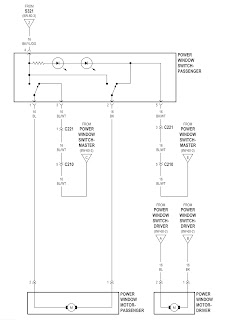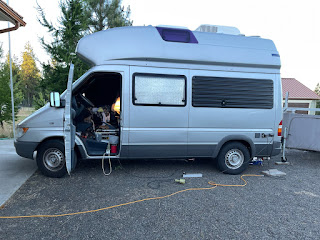Brunnhilde is built on a Mercedes Benz T1N Sprinter that was designed and developed in the late 90s, and mainly as a commercial van with immense cargo or passenger capacity and fuel efficient. Much conveniences of a modern sedan or even SUV or truck were not the the things the designer had in mind in those days. One of these is the ability to operate the front power windows without turning the ignition key to the engine run position.
For a vehicle used for camping and with a diesel engine the shortcomings are many. In cold ambient temperature switching the ignition key to the run position will also turn on the power to the diesel engine glow plugs. The glow plugs draws large amount of current and more important, they have a finite lifespan just like high wattage incandescent light bulbs. The less you cycle and use them the better.
Even without the glow plugs, having to insert the ignition key whenever you want to operate the windows while camping is a major inconvenience and waste of time. When I camp, I have a habit to put away the key in a secure location and only retrieve it when I am ready to leave. Having to dig out the key and use it for such trivial operation only increase the chance of one misplacing it after use, and I have done many times.
I decided to find a good solution for it. Reviewing the Sprinter's wiring diagram I found out the ignition gated power supplying the power window motors is switched by a relay (Optional Equipment Relay) that is fused for 70A and it also supplies power to many other functions. One that I certainly don't want to willy-nilly switch on is the controller for the antilock brake. Otherwise one might just add a momentary SPST switch to energize this relay whenever I want to operate the windows without switching on the ignition key.
Here are the pertinent pages of the wiring diagram:
While it is most simple to just rewire the power sources pre-fuse for both of the power window circuits to a the B+ that is un-gated by the ignition switch, this approach has safety and liability implications. To preserve the original ignition-gated operation and also allow me to operate the windows at will require adding a relay. Since the relay if left energized will consume about 100mA of current, I opted to use a momentary push button SPDT switch. The switch will energize the new relay acting as a push to enable. With the use of a rectifier diode the relay will be energized by the ignition gated power during the time when the ignition key is on. Here is a simple schematic I designed.

I scrounged for a 30A relay and socket for it; these were actually striped out of Brunnhilde when I converted the air conditioner back in 2015
I also found some momentary SPDT switches
all the modification can be done inside the seat box bird nest under the driver seat
I decided the small K&N push button switch is the easiest to mount and most ergonomic to use; I manage to find a single rectifier diode that is just the size I had in mind; it is a 1N4070
I managed to find everything I need from my electronic junk piles without spending a dime and have to wait for the components to be shipped.
as I reused the relay socket harness there are many splices; the harness is taking shape now
the
external 120Vac duplex receptacles came in handy already powering a soldering iron and a heat gun as I also need the light inside the cabin for illumination; this saved from dragging out another long extension cord from the garage or similar scramble while racing the setting sun
the harness is ready to be installed with drilling a hole for the push button switch first; for expedience I chose to mount the 1N4070 diode in line of the wire to the relay coil and cripple it to adjacent wires for support

the location I chose is on the inboard side of the driver seat box at this recessed area
I chose to mount the push to enable switch on the inboard side of the driver seat box. Conveniently there is a recessed area to protect it from being accidentally engaged by the vinyl cover. This location allows the access from when inside the cabin, or when standing on the ground by the driver door, while both window's controls are also within reach.
here are the cut and splice locations at the two fuses for the power window supplies F2 (passenger side) and F13 (driver side) in my case
I use the center post of the EK1 options terminal strip also in the driver side seat box to obtain a 25A fused B+ power
the relay end of the harness is secured to the sheet metal frame for the relay block with a cable tie and the harness is also secured by a number of cable ties to prevent the diode from accidental damage
I re-installed the seat and immediately performed the acid tests - operate from standing on the ground by the driver seat, and from within the cabin


















No comments:
Post a Comment